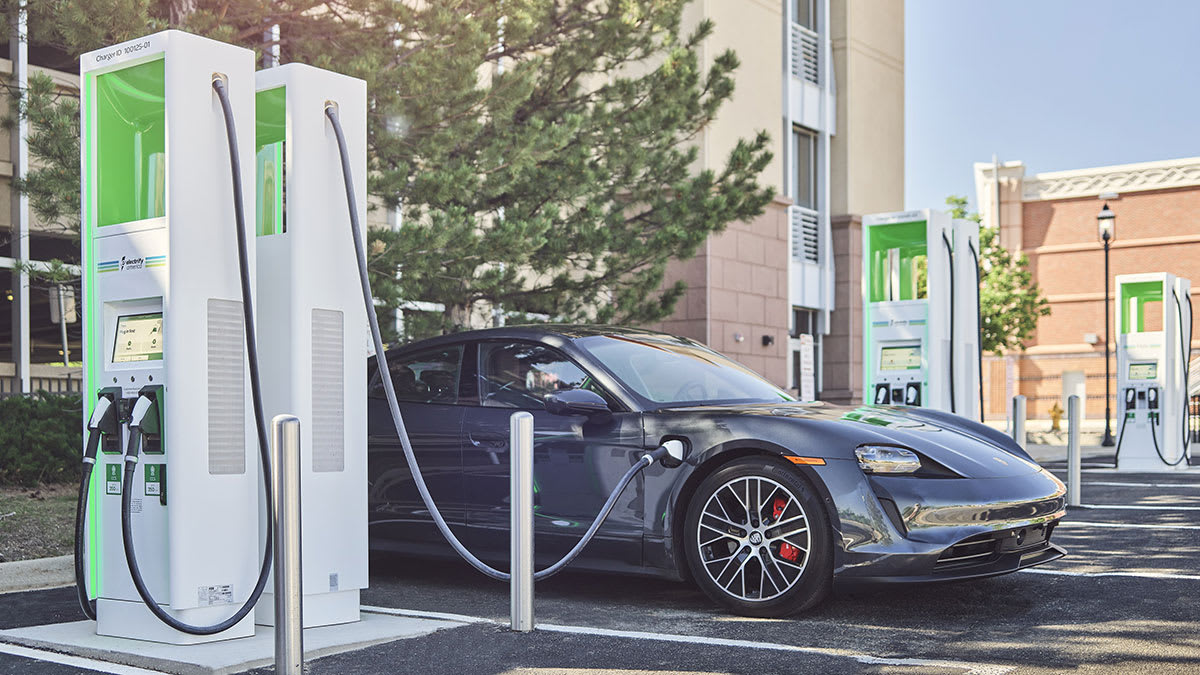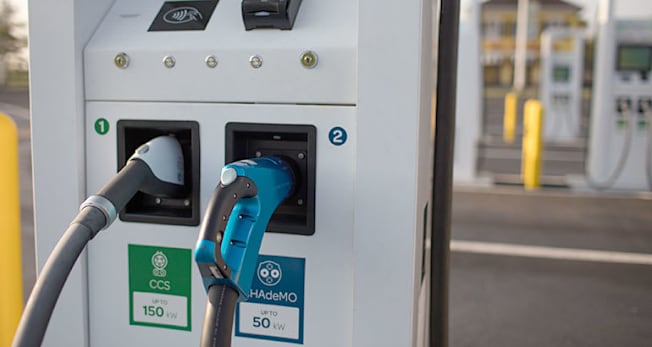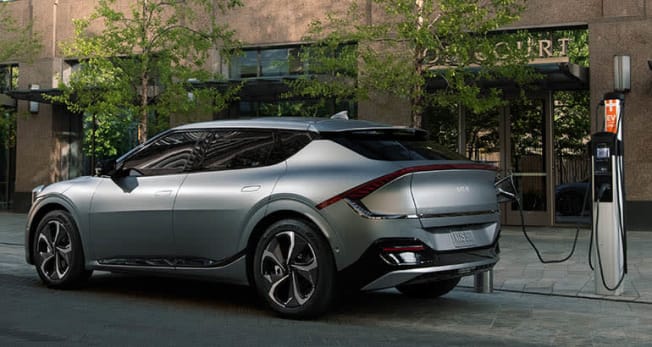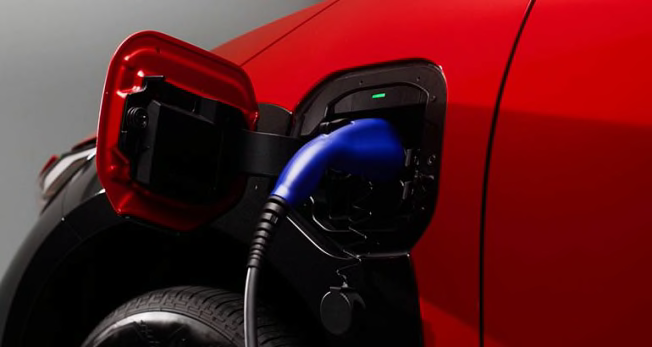How Long Does It Take to Charge These Popular Electric Cars?

These are the fastest-charging EVs you can buy right now—and a few of the slowest
A Porsche Taycan at an Electrify America DC fast charging station.
By Keith Barry
You probably know that electric vehicles take longer to “fill up” than gas-powered cars, but how long you have to wait depends on the car—and it can vary widely. Even at the same charger, some EVs take twice as long as others to add the same number of miles.
Whether you plug in at a 240-volt Level 2 charger at home or work, or plan to use a public DC fast charger (DCFC), how long it takes to charge depends on how fast a charger is and also how fast a charge your vehicle can handle—otherwise known as its “acceptance rate.” The differences can be stark: Some cars can add 200 miles of range in 20 minutes, while others might take more than an hour to do the same.
Automakers like to brag about how quickly their EVs can charge from almost empty to 80 percent full, but we don’t think that’s a very useful number. Because EVs have such different ranges and efficiencies, percentages tell you nothing about how many miles you can actually drive.
“Unfortunately, there’s no standard measurement for reporting how quickly an EV can charge or add miles of range,” says Alex Knizek, Associate Director of Auto Test Development at CR. “That makes it difficult for consumers to compare vehicles when shopping for a new EV.”
That’s why we ranked popular new EVs based on the number of miles of range they add per minute of DC fast charging, and the number of miles of range they add per hour of Level 2 charging. If you want the raw data so you can do the math yourself, CR members can find maximum acceptance rates and estimated charging speeds under “Ratings and Specs” after searching for any new or used electric vehicle on our website.
If you want to learn more, keep reading—or see our guide to EVs and charging. Otherwise, you can read on to see our list of the fastest- and slowest-charging EVs.
Not only is a Nissan Leaf unable to charger faster than many of its competitors, but it also requires a unique "CHAdeMO" plug (right) that is incompatible with other EVs.
The Basics of EV Fast Charging
Charging speed is measured in Kilowatts (kW). The higher the kW, the faster the charge. DC fast chargers from Electrify America, EVGo, and others usually charge between 50 kW and 350 kW depending on the charger, while Tesla Superchargers can charge at 250 kW. But like pouring water from a bucket into a bottle, just because a charging station can rapidly dispense electricity doesn’t mean your car is capable of taking it in at the same rate.
The 2022 Hyundai Ioniq 5, for example, has a maximum acceptance rate of 240 kW and can add up to 11.6 miles of range per minute of charging at a 350 kW DC fast charger. But the 2017 Chevy Bolt has only a 50 kW acceptance rate. That means it can add only about 2.9 miles of range per minute whether it’s plugged into a 50 kW charger or a 350 kW charger. (An etiquette note for Bolt owners: Don’t plug in at an open 350 kW charger if a 50 kW charger is available—you’ll block owners of faster-charging EVs from getting back on the road sooner.)
The same goes for home charging: Many 2017 and earlier Nissan Leaf models only have a 3.3 kW onboard charger, which means they can take more than twice as long as other EVs to charge fully on a typical 40-amp home charger.
Currently, the fastest-available DC fast charging stations are capable of 350 kW.
EVs That Add 10 Miles per Minute or More at a DC Charger
According to data provided by their manufacturers, all of these new vehicles add more than 10 miles per minute of charging under ideal conditions at a public DC fast charging station. Some are as quick as 15 miles of range per minute. CR Members can click on the vehicle names to see their maximum acceptance rates and estimated charging speeds at Tesla Superchargers and 350 kW, 150 kW, and 50 kW fast chargers.
• Audi E-Tron GT
• Chevrolet Silverado EV
• Genesis Electrified GV70
• Genesis Electrified G80
• Genesis GV60
• GMC Sierra EV
• Hyundai Ioniq 5
• Hyundai Ioniq 6
• Kia EV6
• Lucid Air
• Porsche Taycan
• Tesla Model 3
• Tesla Model S
• Tesla Model x
• Tesla Model Y
Our numbers assume the maximum charging speed under optimal charging conditions, including battery state of charge and temperature. Charging speeds tend to slow down once the battery is 80 percent full, and heat and cold can affect how quickly a battery can accept a charge. To calculate, we multiplied each vehicle’s EPA-estimated combined miles-per-kilowatt-hour rating by its maximum DC charging acceptance rate, then divided it by 60. We’ve based our calculations on 350 kW chargers—the cars listed above will charge more slowly at slower chargers.
Older versions of some of these vehicles might not charge at the same speeds. For example, the 2013-2018 Tesla Model S adds around 6 miles of range per minute, depending on the year.
As with many older EVs, if you plug in your Chevy Bolt at a 350 kW charger, it won’t charge any faster than if you plugged it in at a 100 kW or 50 kW charger, because its maximum acceptance rate is 50 kW.
EVs That Add 5 Miles per Minute or Fewer at a DC Charger
These new vehicles all add 5 miles of range or fewer for every minute of charging. CR Members can click on the vehicle names to see their maximum acceptance rates and estimated charging speeds at 350 kW, 150 kW, and 50 kW fast chargers. For the purposes of this list, we assume that a car is plugged into the fastest charger it can handle.
• Fiat 500e
• Jaguar I-Pace
• Kia Niro Electric
• Mercedes-Benz EQB
• Nissan Leaf
• Subaru Solterra
• Toyota bZ4X
EVs That Add 30 Miles or More per Hour at a 240-Volt Level 2 Charger
At a 240-volt 40-amp charger, commonly installed at homes and workplaces, these new vehicles will add 30 or more miles of range for every hour they’re plugged in. If you have access to an 80-amp Level 2 charger, some of these will add 50 or more miles of range per hour. CR Members can click on the vehicle names to see their maximum acceptance rates and estimated charging speeds at 80-, 50-, 40-, and 32-amp Level 2 chargers.
• Fiat 500e
• Hyundai Kona Electric
• Kia EV6
• Kia Niro Electric
• Lucid Air
• Tesla Model 3
• Tesla Model S
• Tesla Model Y
If you have a slower charger or lower-amperage service, your EV might take longer to charge. To calculate, we multiplied each vehicle’s EPA-estimated combined miles-per-kilowatt-hour rating by its maximum AC charging acceptance rate. This rate depends on the vehicle’s on-board charger, which converts AC power to DC charging.
Like other Hyundai, Kia, and Genesis EVs, the Kia EV6 adds more miles than many other EVs when plugged in at a Level 2 charger.
Photo: Kia
EVs That Add 20 Miles per Hour or Fewer at a 240-Volt Level 2 Charger
At a 40-amp charger at home or work, these new vehicles will add 20 or fewer miles of range for every hour they’re plugged in. Vehicles marked with an asterisk charge more quickly at an 80-amp charger, which is more common in commercial settings:
• Chevrolet Silverado EV*
• Ford F-150 Lightning*
• GMC Sierra EV*
• Nissan Ariya
• Subaru Solterra
• Toyota bZ4X
The Subaru Solterra and Toyota bZ4x are among the slowest-charging new EVs on the market.
Photo: Toyota
Consumer Reports is an independent, nonprofit organization that works side by side with consumers to create a fairer, safer, and healthier world. CR does not endorse products or services, and does not accept advertising. Copyright © 2024, Consumer Reports, Inc.
Source link






